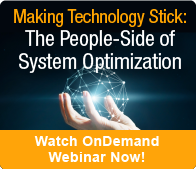True story. Over the past 6 months we have been talking to a potential client who was considering using the Accelerating Implementation Methodology (AIM) as the change management methodology on a transformational ERP system. The client has just taken baby steps in developing a mature project management infrastructure. His concern is whether AIM is too much for the organization to bite off. In other words, is the organization ready for AIM?
Shouldn't the question be whether the organization is ready for the ERP system?
Bottom line: your change management methodology has to be able to address and manage the historic and systemic barriers to change that are part and parcel of all ERP systems! With an ERP, you are not just implementing within a vertical power structure or function; you are implementing cross-functionally, enterprise-wide. Typically you are re-designing and standardizing processes. The investment is enormous, the resource requirements are huge, and the risks are well-documented!
Most often, ERPs are sub-optimized not due to the integrity of the software, but because the human and cultural issues are not managed systematically and systemically. Here are some of the common barriers to change:
- Insufficient leadership (Sponsorship) that actively demonstrates commitment throughout the entire implementation
- Communication that is ineffective because messaging is insufficient and is "one size fits all" rather than tailored to the audience
- Training that focuses on the system, rather than on how users will need to use the system in their jobs. Training doesn't prepare users because it doesn't provide job-specific practice that integrates the system with the new processes (It's system-driven rather than job performance driven.)
- Readiness activities that are focused solely on training and communications rather than also motivating users
- No process for addressing cross-functional decision-making and conflicts at speed
- Managers that are unprepared to address resistance to change, and may in fact be resistant themselves
- A focus on "installing" the technology and the associated new processes rather than "implementing" the change
Given the complexity of an ERP system implementation, what should you be looking for in a change management methodology that will enable you to address these potentially significant barriers to change? What are the must-have's?
1. Operationally-focused. The change management methodology needs to be less about the change journey and more about how you create an enabling project structure that will ensure you have the governance you need at both the program and the workstream level. Managers will need to have practical strategies and tactics that they can use with their direct reports to manage resistance. No matter how beneficial the ERP system is to your business, you will have resistance because you are changing processes, technologies, and ultimately, the way people do their jobs.
2. A methodology that focuses on Sponsorship, Sponsorship, Sponsorship! The most important consideration will be whether your change management methodology guides activities to securing the required Sponsorship through the entire ERP implementation. No tools or templates will take the place of getting the Sponsorship you need. We are talking about active, demonstrated commitment at each level and in all areas that are impacted by the ERP. Sponsors may attempt to deflect reponsibility to the project team, but know that there are specific accountabilities that only Sponsors can fulfill.
3. A systemic approach. The human and cultural barriers you will face are going to pop up time and time again. It is much more efficient to address these systemically and systemically than to have each workstream or sub-project attempt to overcome them.
4. A repeatable process. One of the greatest values of an ERP system is that it drives standardized processes based on best practices. To implement the ERP, you need a repeatable approach that models a "one company solution." If you allow people to use multiple approaches you are only encouraging the silo'd behavior you are trying to eliminate.
5. Integration of change capability-building with the implementation process. The most successful implementations provide change management training so that managers and leaders with the skills and knowledge they need to be good Sponsors. People will repeat past behaviors that have worked well unless they are aware of what they need to do differently, and they are reinforced for the new behaviors.
Before you select your change management methodology, make sure you will have what you need to be successful. The AIM approach ticks all 5 of these requirements-- how about your change management methodology?


